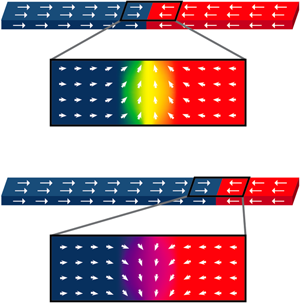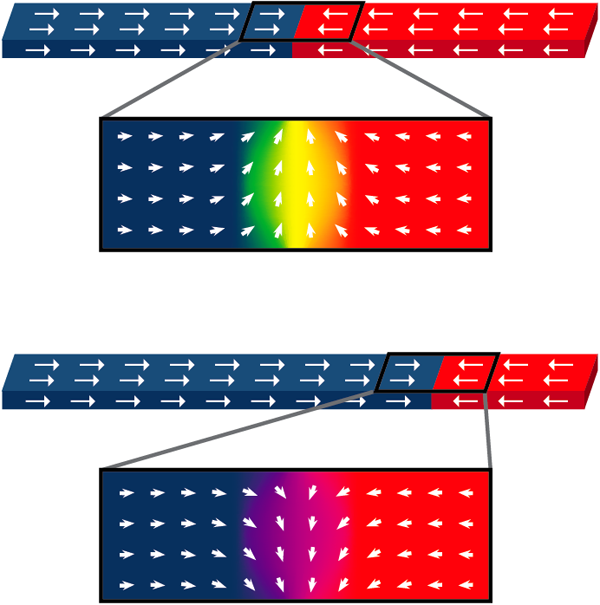Flipping a domain wall switch
The discovery that a spin-polarized current can rotate a nanomagnet has spawned an entire new field within magnetism-based electronics [1–6]. Conventionally, the magnetization of a material or device is switched by applying external magnetic fields. But in nanostructures, the same can be accomplished by injecting a spin-polarized current where the charge carriers (electrons) exert a torque on the magnetization. With this spin-transfer torque effect it is possible to switch the magnetization in multilayer pillars [3] and to push a domain wall—a boundary between two regions of uniform magnetization that point in different directions—along the length of a nanowire [4–6]. This latter effect is the basis of a new type of domain-wall-based data storage device, such as the “racetrack memory” devised by Stuart Parkin from the IBM Almaden Research Laboratory [1].
One of the key requirements for this technology is the control of the domain wall spin structure. In the current issue of Physical Review Letters, Antoine Vanhaverbeke, Andreas Bischof, and Rolf Allenspach from the IBM Zurich Research Laboratory show they can reversibly, and reproducibly, switch between two well-defined domain wall configurations in a magnetic nanowire using a current pulse [2]. They find that the direction of the current determines if the domain wall points “up” or “down,” an effect that poses a challenge to our current understanding of how domain walls transform, but could be very useful for designing current-controlled memory storage.
Figure 1 shows a thin, flat magnetic wire, similar to that studied by the Zurich group, indicating two distinct magnetic domains. The spins in the two domains (red and blue) point in opposite directions so that, at the interface between the domains, a head-to-head domain wall is formed where the spin direction rotates by 180° [5]. The way the spins rotate across this domain wall depends on the geometry of the wire. In particular, in thin wires, the spins rotate transverse to the length of the wire as shown in Fig. 1. These transverse walls can occur with two different polarities—up or down (see magnified views in the top and bottom images of Fig. 1). From a data storage perspective, transverse domain walls are attractive because they occur in particularly narrow and thin wires, which promise the highest storage densities.
As a current traverses a domain wall in a magnetic wire, it displaces the wall in the direction of the electron flow. For sufficiently high current densities (more precisely, above the so-called Walker breakdown [7]), the walls both move and change their configuration [5]. The IBM group looked for similar effects in their thin, flat wires, which are made from (a permalloy). They find that a current flips a transverse wall to the opposite polarity via the nucleation and annihilation of an antivortex—a sort of swirling configuration of spins that consists of both an up and down transverse domain wall—and then again via an antivortex back to the original transverse wall spin structure (see Fig. 1 of Ref. [2]). Since the antivortex does not constitute a stable magnetization configuration, a transverse wall with one of the two polarities always remains when the current is zero.
The typical time to flip the domain wall is a few nanoseconds, so current pulses of this duration are needed to reproducibly switch from one domain wall polarity to the other. Furthermore, since the switching is predicted to be periodic, a pulse that is twice as long would induce two switching events so that the resulting wall polarity is the same as the original one. In practice, Vanhaverbeke et al. apply current pulses that are much longer (1–2 µs) than the average domain wall switching time. Not surprisingly, they find there is a 50% chance that the wall polarity switches after the current pulse and that the switching is independent of the current direction [2].
The group finds a very different domain wall motion in wires made of a double layer of the and . In contrast to the pure permalloy structures, in the bilayers a certain current direction always results in a particular domain wall polarity. The group has therefore found a deterministic way to obtain a certain domain wall spin structure even for microsecond-long pulses. One possible explanation of their finding is that the current flow through the bilayer, which is not homogeneous because of the different resistances of Fe and the permalloy, produces a large Oersted field that biases the domain direction. However, while calculations show this induced field would favor one domain wall polarity over another, it is the opposite polarity to that found by the Zurich group experimentally.
This key finding, namely the ability to set the transverse wall polarity in a -permalloy double layer by choosing the appropriate current direction for a current pulse, is not explained by the current state-of-the art theory. This means that the model of current-induced domain wall motion needs to be extended, perhaps to include thermal excitations, which are usually neglected. Furthermore, simulations typically assume an idealized wire structure, while in the actual wire, irregularities can lead to domain wall pinning. Pinning is inherently difficult to simulate, but these experiments may well inspire theoretical models to take on the challenge.
This novel way to set the transverse wall polarity could have potential advantages for applications. By appropriately designing a wire with single and double-layer sections, the polarities could be deterministically set and geometrical variations in the wire can be designed to allow only one wall polarity to pass, while the opposite polarity is blocked [8]. The transformations that occur in manipulating a domain wall with a current have always added a complication to domain-wall-based devices. Now this robust means of controlling the domain wall transformations provides an extra degree of freedom and turns a nuisance into an asset.
References
- S. S. P. Parkin, M. Hayashi, and L. Thomas, Science 320, 190 (2008)
- A. Vanhaverbeke, A. Bischof, and R. Allenspach, Phys. Rev. Lett. 101, 107202 (2008)
- J. A. Katine, F. J. Albert, R. A. Buhrman, E. B. Myers, and D. C. Ralph, Phys. Rev. Lett. 84, 3149 (2000)
- A. Yamaguchi, T. Ono, S. Nasu, K. Miyake, K. Mibu, and T. Shinjo, Phys. Rev. Lett. 92, 077205 (2004)
- M Kläui, J. Phys. Condens. Matter 20, 313001 (2008)
- M. Kläui, P-O. Jubert, R. Allenspach, A. Bischof, J. A. C. Bland, G. Faini, U. Rüdiger, C. A. F. Vaz, L. Vila, and C. Vouille, Phys. Rev. Lett. 95, 026601 (2005)
- N. L. Schryer and L. R. Walker, J. Appl. Phys. 45, 5406 (1974)
- D. Petit, A.-V. Jausovec, D. Read, and R. P. Cowburn, J. Appl. Phys. 103, 114307 (2008)





